Xiaohui Jing, Menglin Han, Xiaoxuan Wang & Li Zhou BMC Infectious Diseases volume 23, Article number: 577 (2023) Cite this article Update published on 02 October 2023
Abstract
Background
Corona Virus Disease 2019 (COVID-19) mRNA vaccine effectiveness (VE) has recently declined, and reports about COVID-19 breakthrough infection have increased. We aimed to conduct a meta-analysis on population-based studies of the prevalence and incidence of severe acute respiratory syndrome coronavirus 2 (SARS-CoV-2) breakthrough infection amongst older adults worldwide.
Methods
Studies from PubMed, Embase, Cochrane Library, and Web of Science were systematically screened to determine the prevalence and incidence of SARS-CoV-2 breakthrough infection in older adults from inception to November 2, 2022. Our meta-analysis included 30 studies, all published in English. Pooled estimates were calculated using a random-effect model through the inverse variance method. Publication bias was tested through funnel plots and Egger’s regression test, and sensitivity analyses were performed to confirm the robustness of the results. This research was performed following the Preferred Reporting Items for Systematic Reviews and Meta-Analyses (PRISMA) guidelines.
Results
Thirty publications were included in this meta-analysis (17 on prevalence, 17 on incidence, and 4 on both). The pooled prevalence of COVID-19 breakthrough infection among older adults was 7.7 per 1,000 persons (95% confidence interval [95%CI] 4.0–15.0). At the same time, the pooled incidence was 29.1 per 1000 person-years (95%CI 15.2–55.7).
Conclusions
This meta-analysis provides estimates of prevalence and incidence in older adults. We concluded that the prevalence and incidence of SARS-CoV-19 breakthrough infection in older people was low. The prevalence and incidence of breakthrough infection admitted to hospital, severe-critical, and deathly was significantly lower. Otherwise, there was considerable heterogeneity among estimates in this study, which should be considered when interpreting the results.
Introduction
The COVID-19 pandemic caused by SARS-CoV-2 continues to constitute a public health emergency of international concern (PHEIC). Moreover, COVID-19 with a high number of deaths compared to other respiratory infectious diseases [1]. Globally, as of February 22, 2023, there have been COVID-19, including 6,86,850,594 deaths and 757,264,511 confirmed cases, reported to WHO [2].
Currently, COVID-19 vaccination is recognized as one of the most extraordinary measures to control the global COVID-19 pandemic, reducing the morbidity of COVID-19. As of February 21, 2023, there were 180 candidate vaccines in clinical development and 199 in pre-clinical development, including the following main categories: protein subunit vaccines, viral vector vaccines, inactivated virus vaccines, and DNA- and mRNA-based vaccines, among others [3].
Vaccines against SARS-CoV-2 have effectively prevented COVID-19, but rare breakthrough infections have been reported. A study found that the immune effect of older adults after being vaccinated with COVID-19 vaccines was less effective than that of young people. Still, safety is higher in older people after vaccination [4]. Older adults may represent a vulnerable group with a higher risk of breakthrough infection, worse outcomes, and even death from COVID-19 than young adults. Therefore, there is a concern for the prevalence and incidence rate of SARS-CoV-2 breakthrough infection amongst older adults. Based on studies, we conducted a meta-analysis to estimate the prevalence and incidence of SARS-CoV-2 breakthrough infection amongst older adults and compare the prevalence and incidence in different degrees of severity.
We adopted the definition of breakthrough infection as testing positive for SARA-COV-2 via reverse-transcription polymerase chain reaction (RT-PCR) or rapid antigen-detection diagnostic test from any sample (i.e., nasal swab, nasal wash, nasopharyngeal swab oropharyngeal swab, saliva, sputum, bronchoalveolar lavage fluid, pleural fluid, or lung tissue.) in any clinical setting regardless of the degree of severity after 14 days since the last dose of any SARS-CoV-2 vaccine [5,6,7].
Materials and methods
Search strategy
A systematic literature search was conducted using PubMed, Cochrane Library, Embase, and Web of Science databases to identify all relevant studies until November 2, 2022. The snowballing method was used to hand searching of the reference lists of relevant studies during the same period.
The MeSH terms were:
- (1)“COVID-19 breakthrough infections” [Title/Abstract])
- (2)“elderly” [Title/Abstract]
- (3)“COVID 19 Vaccines” [Title/Abstract]
The above search terms were run in PubMed and were customized for each database when necessary.
The literature obtained by the systematic search is managed by NoteExpress, and duplicate literature is deleted with NoteExpress. We screened the titles and abstracts of obtained studies to delete irrelevant studies. At last, XH J and ML H independently conducted full-text screening to determine eligibility. Any discrepancies were resolved by discussion with XX W.
Inclusion criteria
Studies were included if (1) They contain a cohort of older adults vaccinated for at least 14 days regardless of sex and geographic location, (2) The prevalence or incidence of SARS-CoV-2 breakthrough infection among older adults was reported, or it could be calculated based on available data in the article. (3) They were cross-sectional, cohort, or randomized controlled studies.
Exclusion criteria
Studies were excluded if (1) They were reviews, letters, comments, protocols, conference abstracts, systematic reviews, meta-analyses, case reports, animal studies, preprint studies, case–control studies, or test-negative design studies, (2) They examined older adults living in institutions (i.e., living in nursing homes, long-term care facilities or sheltered) because they were more likely to have a functional impairment and low self-rated health condition [8]. (3) They did not report sufficient data and information, and efforts to contact the authors were unsuccessful. (4) Their older population sample size was less than 500. (5) They were published in different articles with duplicate participants.
Quality assessment and data extraction
Two reviewers assessed the risk of bias in the cohort studies using the NOS (The Newcastle–Ottawa Scale), the risk of bias in the randomized controlled studies using the Cochrane Risk of Bias tool, and the risk of bias in cross-sectional studies using the JBI (Joanna Briggs Institute) Critical Appraisal Checklist for Analytical Cross-Sectional Studies. For cohort studies, A scores from 7–9, 4–6, and 1–3 were, respectively, deemed as high, moderate, and low quality. For Cross-Sectional Studies, A score from ≥ 5, 3–4, and 0–2 were, respectively, considered as high, moderate, and low-quality [9]. Two reviewers independently assessed the quality of each included study, and disagreements were resolved by consensus. Furthermore, we contacted the authors for data collection in our meta-analysis when the article did not report enough information.
We used a standardized Excel form to extract data from the included studies, including the study author, publication year, country, study type, vaccine type and dose, study period, age range, sample size, and breakthrough infection regardless of the degree of severity, breakthrough infection at distinct severity stages (Symptomatic SARS-CoV-2 breakthrough infection, breakthrough infection admitted to hospital, Severe–critical breakthrough infection, and breakthrough infection death), person-years (convert person-days into person-years according to 365 days of a year), and the number of older adults with SARS-CoV-2 breakthrough infection. And two reviewers (XH J and ML H) independently extracted these data.
Statistical analysis
For each study included in the analyses, the prevalence was estimated in each group by dividing the number of breakthrough infection cases in older adults by the total number of older individuals receiving the vaccine. Similarly, the incidence expressed in person-years was calculated by dividing the number of older individuals who were breakthrough infected during a specified time frame by the total number of person-years vaccinated during that time.
Statistical analyses were performed using R version 4.2.2. Pooled prevalence and incidence and corresponding 95% confidence interval (CI) were obtained using the metaprop and metarate functions in the meta statistic package [10]. Using log transformation, the random-effects model was employed through the inverse variance method to pool prevalence and incidence. We use forest plots to describe statistical results.
Heterogeneity among the studies was evaluated by the I2 statistics, in which I2 values from 50–90 may represent substantial heterogeneity, and from 75% to 100 indicated considerable heterogeneity [11]. The significance of the heterogeneity test was assessed using Cochran’s Q test, in which a p-value of < 0.05 implied significant heterogeneity. A subgroup analysis was carried out based on different degrees of severity: Symptomatic SARS-CoV-2 breakthrough infection, breakthrough infection admitted to hospital, Severe–critical breakthrough infection, and breakthrough infection death. Publication bias was tested through the apparent symmetry of the funnel plot and Egger’s regression test, where a statistically significant intercept at α = 0.05 indicated evidence of funnel plot asymmetry. And leave-one-out sensitivity analyses were performed to confirm the robustness of the results.
Results
Literature screening process and results
Initially, 1,044 studies were searched from English databases, among which 14 were from PubMed, 288 from EMBASE, 17 from Cochrane Library, and 725 from Web of Science. Hand-searching contributed to 110 studies. After reading the complete text, the studies that did not meet the inclusion criteria were excluded and finally included in the meta-analysis. A total of 17 studies reported the prevalence of COVID-19 breakthrough infection among older adults, 17 on incidence, and 4 on both. The study selection procedure is outlined in Fig. 1.
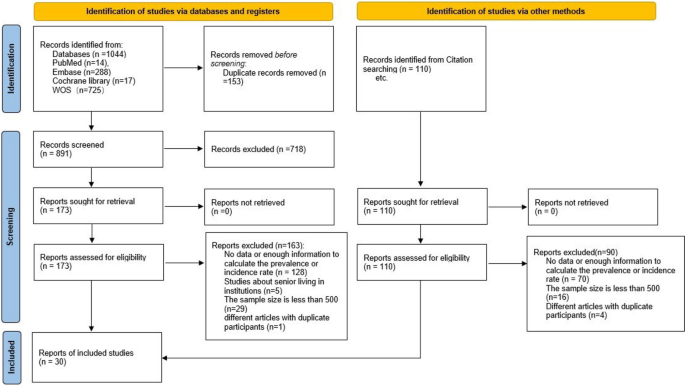
Baseline characteristics and risk of included studies
Most of the included studies were cohort studies (19/30,63.33%), cross-sectional studies (5/30, 16.67%), and randomized controlled studies (6/30,20.00%). The details of included studies are shown in Table 1. The risk of bias in included studies is graphically demonstrated in Table 2, Table 3, and Table 4. All types of studies included were of moderate to high quality. Only 4 cohort studies were of moderate quality, and the other 26 were of high quality.Table 1 Characteristics of studies included in the systematic review
Full size tableTable 2 Bias assessment of the included cohort studies
Full size tableTable 3 Bias assessment of the included cross-sectional studies
Full size tableTable 4 Bias assessment of the included randomized controlled studies
The prevalence of meta-analysis of outcome
The prevalence of breakthrough infection among older adults
Based on 17 studies involving 14,579,373 older adults with different vaccines, doses, and health conditions, the prevalence ranged from 0.7 to 59.7 per 1000 individuals. The pooled prevalence of SARS-CoV-2 breakthrough infection in older adults was 7.7 (95%CI 4.0–15.0) per 1000 individuals. The studies included in this meta-analysis had considerable heterogeneity, as shown by an I2 value of 99.98% and a statistically significant Q test (p = 0) (Fig. 2).
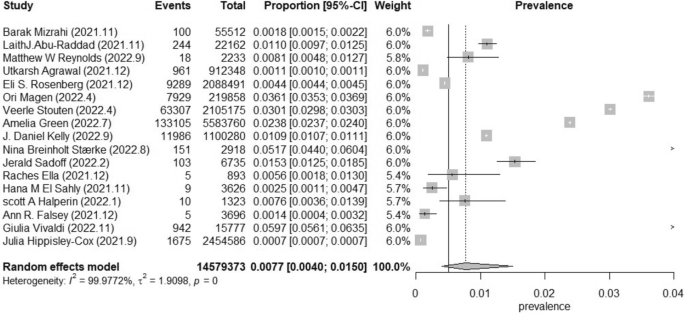
Subgroup analysis based on the degree of severity of the breakthrough infection
Upon classifying the degree of severity of the breakthrough infection among older adults, it was noted that symptomatic breakthrough infection had a prevalence of 6.1 (3.4–10.9) per 1000 individuals, the pooled prevalence of breakthrough infection admitted to hospital was 1.2 (0.6–2.5) per 1000 individuals, the pooled prevalence of severe–critical breakthrough infection was 1.1 (0.2–7.4) per 1000 individuals, and the pooled prevalence of breakthrough infection deathly was 0.5 (0.2–1.7) per 1000 individuals (Fig. 3). By subgroup analysis of the prevalence of breakthrough infection in different degrees of severity, I2 was not significantly reduced.
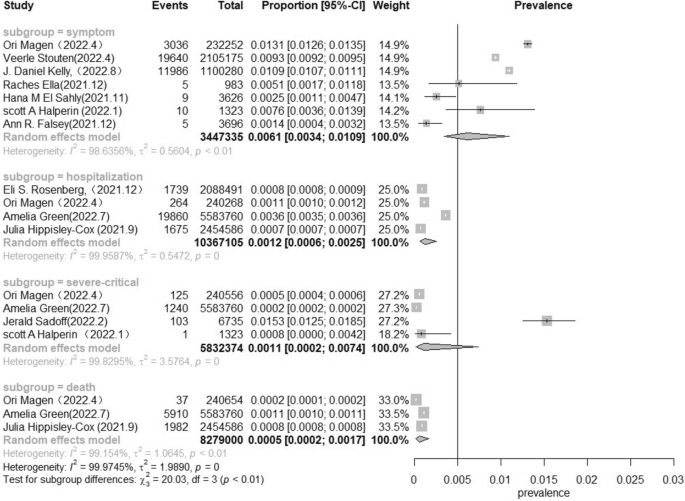
Publication bias and sensitivity analysis
We tested the 17 studies for publication bias, and there was no evidence of publication bias for any of the estimates of prevalence using visual inspection of funnel plots or the Begg or Egger test (all p > 0.05) (Fig. 4). A sensitivity analysis that omitted one study did not significantly change these estimates. (6.8 per 1000 individuals versus 9.1 per 1000 individuals) (Fig. 5).
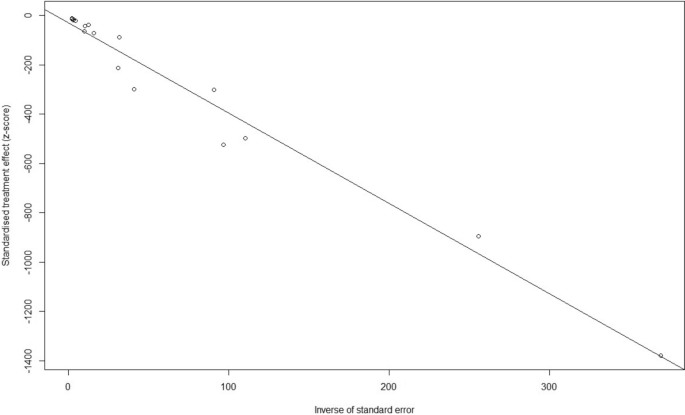
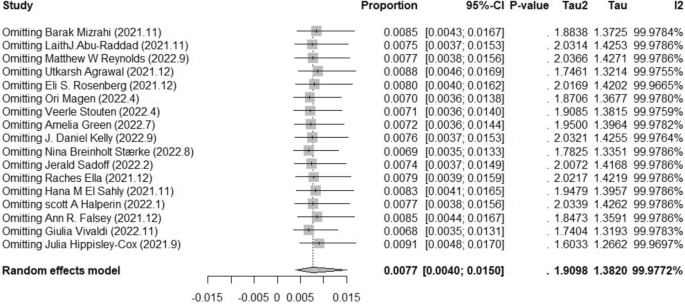
The incidence of meta-analysis of the outcome
The incidence of breakthrough infection among older adults
Based on 17 studies, incidence ranged from 4.1 to 1,016.6 per 1000 person-years. The pooled incidence of breakthrough infection in older adults with different vaccines, doses, and health conditions was 29.1 (15.2–55.7) per 1000 person-years. The studies included in this meta-analysis had considerable heterogeneity, as shown by an I2 value of 100.00% and a statistically significant Q test (p = 0) (Fig. 6).
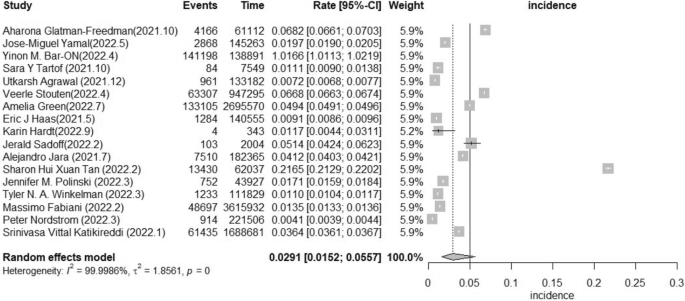
Subgroup analysis based on the degree of severity of the breakthrough infection
Upon classifying the severity of the breakthrough infection among older adults, it was noted that symptomatic breakthrough infection had an incidence of 16.8 (5.4–52.6) per 1000 person-years, the pooled incidence of breakthrough infection admitted to hospital was 6.4 (4.1–9.9) per 1000 person-years, the pooled incidence of Severe–critical breakthrough infection was 4.9 (1.7–14.3) per 1000 person-years, and the pooled incidence of breakthrough infection deathly was 1.6 (0.7–3.9) per 1000 person-years (Fig. 7). By subgroup analysis of the incidence of breakthrough infection in different degrees of severity, I2 was not significantly reduced.

Publication bias and sensitivity analysis
We tested the 17 studies for publication bias, and there was no evidence of publication bias for any of the estimates of incidence using visual inspection of funnel plots or the Begg or Egger test (all p > 0.05) (Fig. 8). A sensitivity analysis that omitted one study did not significantly change these estimates. (23.3 per 1000 person-years versus 32.9 per 1000 person-years) (Fig. 9).
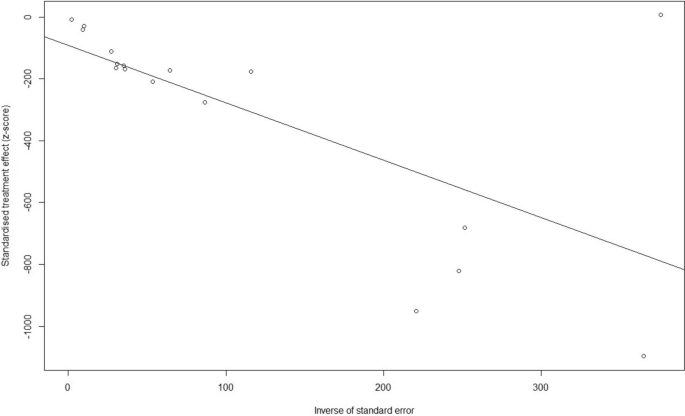
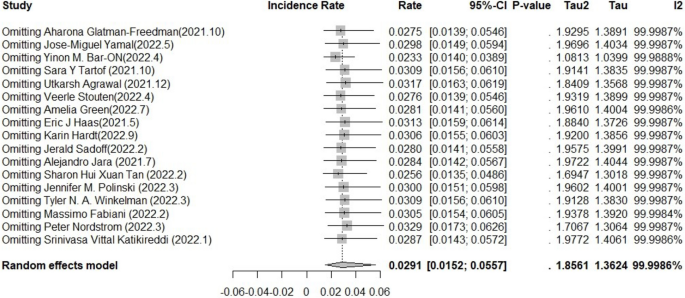
Discussion
This is a meta-analysis of international studies on the prevalence and incidence of SARS-CoV-2 breakthrough infection among older adults. Our findings suggest that the pooled prevalence of breakthrough infections was 7.7 per 1000 individuals, and the pooled incidence of breakthrough infection was 29.1 per 1000 person-years. This indicates that the vaccine efficacy in older adults is still relatively high. Prevalence and incidence and corresponding 95% confidence interval (CI) were summarized using metaprop and metarate in the meta-analysis statistics package. Publication bias was tested through funnel plots and Egger’s regression test, and leave-one-out sensitivity analyses were performed to confirm the robustness of the results.
In this meta-analysis, incidence is higher than prevalence, Firstly most of the studies included in this study were observed within six months of vaccination. And different studies included were observed for different lengths, which may result in higher incidence than prevalence. In particular, people with breakthrough infections have milder symptoms, faster recovery, shorter hospital stays, and are less likely to be infectious than primary infections which may lead to a decrease in the prevalence [41,42,43].
We can observe considerable heterogeneity in the included studies, as indicated by high I2. However, this observation is common in meta-analyses estimating prevalence and incidence. Due to the nature of non-comparative proportional data, we often observe diverse point estimates among different studies than for comparatives [44]. Also, including studies with substantial sample sizes and, thus, minor standard errors led to an overestimation of the I2 statistic [45, 46].
Vaccines cannot provide 100% protection. Recently, estimates of COVID-19 mRNA vaccine effectiveness (VE) have declined, and reports about COVID-19 breakthrough infection have increased. The body’s immune system can remember past infections but cannot guarantee a lasting response. Some infections and immunizations provide lifelong protection, but for others, regular reminders in the form of booster shots or new, reformulated vaccines are required [47].
Immunosenescence (a process of dysfunction) occurs with age leading to changes in the immune function of older adults [48]. Combined with decreased organ spirometry and comorbidities, older adults are more likely to develop breakthrough infections. A study about hospitalized patients with breakthrough COVID-19 infection shows that the hospitalized patients with breakthrough infection were composed mainly of older men with multiple comorbidities [49]. The mortality of patients over 65 years old hospitalized with COVID-19 after a vaccine breakthrough infection remained high but might be lower than that of unvaccinated hospitalized older patients [50].
And due to the weakening of vaccine-induced immunity over time, Vaccine protection against symptomatic disease begins to decline around 10 weeks from the second dose. The waning of protection against hospitalization was more significant among older adults [51]. But the third ‘booster’ dose seems to help. One report found about 60–70% protection from an infection two weeks after the third dose, and protection from severe illness seems strong [52], also because of the increased immune evasion by SARS-CoV-2 variants. In 2022, Omicron swept the globe. Some data suggest that existing vaccines designed for the original SARS-CoV-2 cannot provide much protection against infection with the variant, even though they seem to reduce the risk of hospitalization or death [47].
Older adults with COVID-19 breakthrough infections have a lower viral load, shorter hospital stays, and are less likely to be infectious than primary infections [43]. While some of these breakthrough infections could lead to secondary transmissions, and indeed some of them did have high viral loads, the risk of onward transmission is reduced compared to primary infections. The mRNA vaccines seem to protect not only against the acquisition of infection but also against transmission of infection. We must scale up vaccination globally to robustly control infection transmission and the extent of the pandemic [51]. Therefore, vaccination is recommended for unvaccinated older people.
Vaccine allocation is also a problem in the initial rollout of vaccines when doses are still scarce. Guidelines for vaccine prioritization have been elaborated by the Strategic Advisory Group of Experts of the WHO (WHO, 2020) and the US Advisory Committee on Immunization Practices (ACIP) of the CDC (Dooling et al., 2021), making older adults one of the priority groups to be vaccinated [53].
With the emergence of new variants and the gradual increase in breakthrough infections, many countries have implemented booster dose schedules. However, in the world, only 34.4% of people received a booster by Feb 26, 2023. In some low- and middle-income countries such as India, the percentage of people who received a booster has been only 6.52% [54]. Therefore, there is an urgent need to thoroughly learn more about the safety and efficacy of boosters to reduce people’s hesitancy about vaccines, and to date, there has been no significant difference in the incidence of adverse effects between the second dose and the booster dose in most clinical studies [55, 56].
Due to the increasing global demand for vaccine boosters, different booster vaccination regimens are needed to increase coverage in times of vaccine shortage. However, knowledge of the safety and efficacy of homologous or heterologous booster vaccination still needs to be improved. Therefore, there is an urgent need to assess the effectiveness and safety of different booster vaccination regimens to inform the vaccine policies of countries using these vaccines [50].
In addition, another issue to highlight is the need for more equitable distribution of COVID-19 vaccines. However, while few high-income countries’ governments understand how to vaccinate their whole populations during the pandemic, most low- and middle-income countries have been trusting the COVID-19 Vaccines Global Access (COVAX) to acquire enough doses to vaccinate 20% of their population [56]. COVAX is dedicated entirely to accelerating the development and manufacture of COVID-19 vaccines and ensuring vaccines reach poor countries. And it is might urgent to rationalize vaccination policies, particularly for older adults, frail patients, and their caregivers. Public vaccine improvement efforts should decrease all characteristics of public health risk instead of favoring its business financial characteristics [57].
Study limitations
This report has some limitations. First, it was restricted to studies published in English, excluding potentially relevant studies in other languages. Secondly, the inclusion of studies with a sample size greater than 500 may result in the loss of small eligible studies. Thirdly, considerable heterogeneity was observed in the included studies, as indicated by high I2. And it was not possible to explore the causes of the heterogeneity and come up with a more valid estimate. Caution should be exercised when interpreting pooled estimates of prevalence and incidence separately. Fourthly, most of the studies included in this study were observed within six months of vaccination. More research is needed to prove that vaccines protect older people against infection for longer. Finally, some studies provided little information about the potential influencing factors such as vaccine type, vaccine dose, gender, prior infection, time from vaccination to breakthrough infection, comorbidity, and lifestyle of the included older adults on the prevalence and incidence of COVID-19 breakthrough infection. It was also impossible to conduct meta-analyses among some groups due to the less information from studies assessing those factors. so more research is needed to explore these issues.
Publication implications
This study shows that for the elderly population, the prevalence and incidence of breakthrough infection after vaccination are low. That reduces the hesitation of the elderly for vaccination and increases people’s willingness to vaccinate. It is conducive for humans to control and termination of the COVID-19 epidemic.
Suggestions for future study
Firstly, longer studies can be conducted to determine the prevalence and incidence of breakthrough infections over a longer period after vaccination. Secondly, the difference in prevalence and incidence of breakthrough infection between previously infected and vaccinated populations can be studied. Thirdly, if more information about the health status, different variants of SARS-CoV-2, and sex of the study population is available, the impact of these factors on prevalence and incidence can be studied. Finally, the Short- or long-term health status of older adults after breakthrough infection.
Conclusion
The findings suggest that the prevalence and incidence of SARS-CoV-19 breakthrough infection in older people was low. Therefore, older people should be less hesitant about vaccines. Since most of the current research on breakthrough infection in the older adults is within 6 months after vaccination, a longer observation study of breakthrough infection in the older adults should be conducted to provide more adequate evidence for the protection of the older adults by vaccines.
